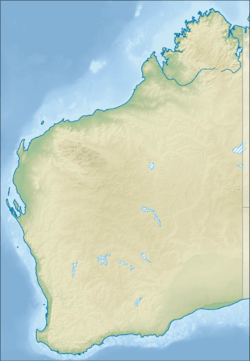Lake Gore facts for kids
Quick facts for kids Lake Gore |
|
|---|---|
| Location | Goldfields-Esperance, Western Australia |
| Coordinates | 33°46′31″S 121°31′24″E / 33.77528°S 121.52333°E |
| Type | Seasonal freshwater |
| Primary inflows | Dalyup River |
| Basin countries | Australia |
| Designation | Lake Gore Nature Reserve; Lake Gore Ramsar Site |
| Max. length | 2.5 km (2 mi) |
| Max. width | 2.5 km (2 mi) |
| Surface area | 740 ha (1,829 acres) |
| Average depth | 1.4 m (5 ft) |
| Max. depth | 2 m (7 ft) |
| Water volume | 10 m (33 ft) |
| Designated: | 5 January 2001 |
| Reference #: | 1049 |
Lake Gore is a special lake in Western Australia, about 24 kilometers (15 miles) west of Esperance. It's a freshwater lake that sometimes dries up, but it's usually full of water. This lake is super important because it's a home for thousands of amazing waterbirds!
Contents
Discovering Lake Gore
Lake Gore is nearly round, like a big circle. It has a few smaller lakes nearby, like Lake Kubitch and Carbul Lake. Another larger lake, Quallilup Lake, is found further south near Shelley Beach. The area around the lake is a flat coastal plain.
How Lake Gore Gets Its Water
Most of the water in Lake Gore comes from the Dalyup River. This river flows right into the lake. Other nearby lakes get their water from Coobidge Creek.
The deepest the lake has ever been recorded was about 2 meters (6.6 feet) in 1986. Usually, it's about 1.4 meters (4.6 feet) deep. Sometimes, the lake can dry up completely, which last happened in 1984.
The water in Lake Gore is clear and doesn't have much color. Its saltiness changes depending on how much rain there is. When it rains a lot, the water is less salty. As the lake dries out in summer, it becomes saltier. Local school students help keep an eye on the water quality and salt levels as part of a program called Ribbons of Blue.
Amazing Plants and Animals
The areas around Lake Gore have a narrow band of woodland trees, mostly saltwater paperbark. Underneath these trees, you can find sedges, which are grass-like plants. Some examples are coastal saw-sedge and Schoenus brevifolius.
Birds of Lake Gore
Lake Gore is a fantastic place for birds! More than 20,000 birds visit the lake every year. It's especially important for the hooded plover. About one-third of all the hooded plovers in the world live here!
The lake is also a key spot for Australian shelducks when they are changing their feathers. It's a safe place for many ducks and shorebirds to go when other areas are dry. Up to 10% of the world's banded stilts also call Lake Gore home.
Because so many important birds live here, BirdLife International has named the Lake Gore system an Important Bird Area (IBA). This means it's a globally important place for bird conservation.
Protecting Lake Gore
Lake Gore is part of Nature Reserve 32419, which is a special area set aside to protect nature. The wetlands around the lake cover a huge area of about 4,017 hectares (9,926 acres).
This wetland area is so important that it was recognized internationally on January 5, 2001. It became a Ramsar Site, which means it's a wetland of international importance. Lake Gore is also listed as a DIWA-listed wetland.


